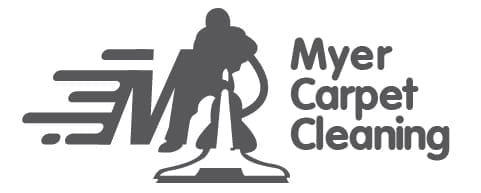At Myer Carpet Cleaning, we believe knowing how to clean a rug is vital for keeping our homes fresher and more aesthetic!
In this guide, we’ll give you our top essential tips and tricks for how to clean a rug at home while also covering general rug maintenance, dealing with stains and spills effectively, and how different rug materials will affect the way you go about cleaning them.
Let’s get started!
How to Clean a Rug: In-Depth Guide
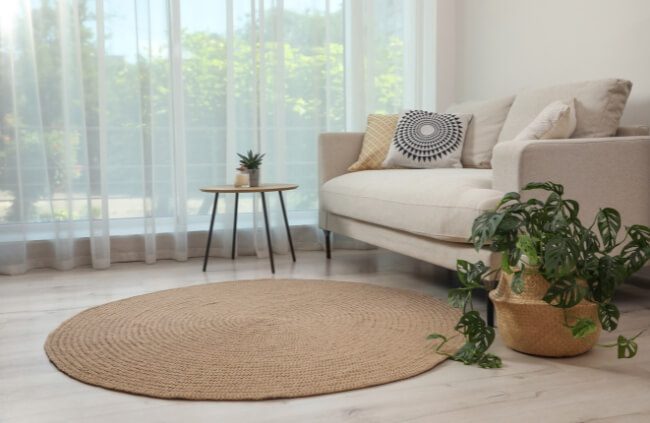
While area rugs can brighten up our living spaces, help keep us warm in winter, and add some character to our homes, they are also unfortunately prone to accumulating dust, dirt, debris, food crumbs, and much more.
Foot traffic, pet hair, air pollution, and spills can quickly lead to our rugs looking run down so by properly deep-cleaning your area rugs, you will help prolong their lifespans, keep them looking their best, and keep your home feeling fresher for longer.
While regularly vacuuming and spot-treating rugs can help with general rug care and rug maintenance, unfortunately, it isn’t the best way to clean a rug – especially when considering deep cleaning.
Cleaning Different Types of Rug Materials
Before cleaning your rugs, we recommend always checking the label for the manufacturer’s guidelines. They will often describe the best way to clean a rug of that particular composition.
Today, rugs are made from a large variety of materials – whether natural, organic, synthetic, or combinations of material types, every rug has an ideal way to clean it without causing any unwanted damage.
Natural Fibre Rugs
Rugs made from natural fibres like wool rugs or cotton rugs need to be cleaned differently than stronger synthetic materials like polyester and polypropylene. Because natural fibres are far more delicate, they are usually best treated with a cold water process using gentle cleaning solutions.
Synthetic Rugs
A synthetic rug, like a polyester rug, can handle much more aggressive cleaning methods. They can typically handle hot water and a stronger cleaning solution. You can usually just machine wash small synthetic rugs like welcome mats and bathroom mats on a gentle cycle. Just be sure to check the care tag to make sure it’s machine washable first.
Special and Delicate Rugs
Specific cleaning instructions must be followed when cleaning special and delicate rugs. If you have an antique rug, Persian rug, or Oriental rug, we recommend getting these rugs professionally cleaned.
Rugs made from materials like silk or viscose may also require a professional cleaner. If you buy an antique rug, try to learn as much as you can from the seller about the rug’s construction and recommend care instructions.
Eco-Friendly Rugs
Rugs made from natural, eco-friendly materials will also require special care when cleaning them. This includes rugs made from materials like jute, sisal, hemp, seagrass or coir.
These natural fibres also usually feature an open weave design that allows dirt and debris to sift through to the underlying floor, meaning they don’t tend to accumulate as much filth. A good regular vacuum and flip is usually enough.
Choosing Your Cleaning Solution
There are a few effective cleaning solutions you can use to deep clean rugs at home. Some are stronger than others so for this reason, we recommend first checking your rug can withstand the chemical, product, or device by referencing the manufacturer’s guidelines.
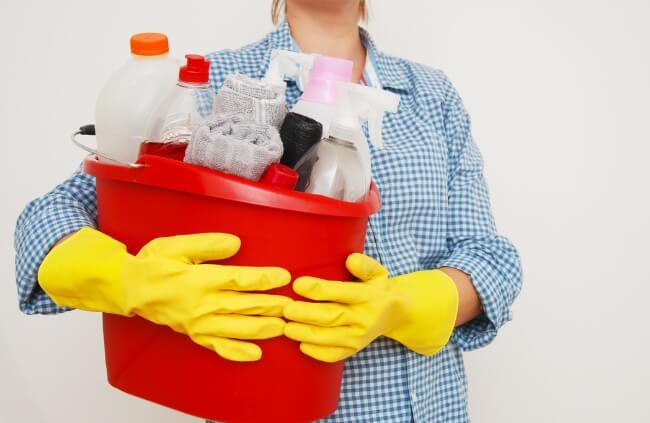
Mild Dish Detergent
A great all-round cleaning solution for most everyday rugs! Mix 1 to 2 teaspoons of mild detergent in a bucket with warm water for synthetic fibres or cold water for wool rugs. A detergent will help lift stubborn stains and dirt from your rugs so you can effectively clean the surfaces.
White Vinegar and Water for Stains
Vinegar should be used sparingly to remove targeted stains from only synthetic fibre rugs. Mix a small amount of white vinegar with some water to effectively target everyday stains. When treating stains, be sure to only dab stains with a paper towel or clean cloth. Try to avoid rubbing the stain deeper into the rug.
Specially Designed Rug Cleaner
While it may be tempting to use a carpet cleaner or carpet shampoo on your rugs, it’s not the best cleaning method. The chemicals are usually just too strong for rugs and end up damaging the fibres.
Instead, use a specifically designed rug shampoo mixed with clean water for the best results. You can get both dry and liquid rug shampoos for different rug types.
Vacuum Cleaner
You can use your vacuum cleaner to pick up a lot of loose dirt and debris from your rugs. Try to use the best brush head for your rug’s material. A soft brush will work great on more delicate materials like a wool rug whereas stiffer brush heads will suit synthetic fibres more.
If your vacuum has a steam clean function, even better! Regular vacuuming is an essential part of basic rug care and rug maintenance.
Washing Machine
Many modern rugs are suitable for machine washing. Rugs made from cotton or synthetic fibres like shag rugs are usually machine washable so long as you use a gentle cycle and cold water.
Be careful placing rugs with rubber backs into the washing machine regularly as it can cause damage over time. Care tags will normally always indicate if the material is machine washable or not.
Recommended Tools for Rug Cleaning
- Rug shampoo or a mild dish soap or detergent
- Bucket
- Water
- Soft-bristled brush, sponge, or cloth
- Rubber gloves for safety
- Vacuum cleaner
- Washing machine
- Towels
How to Clean a Rug: Step-by-Step Guide
1. Prep Your Rug
Prep your rug by clearing any furniture and other objects off. If possible, it is always best to take your rug outside. You can use quite a lot of water when cleaning to remove as much soil and debris as possible, so this is best done outside on a sunny day.
Rugs should also be dried as quickly as possible to ensure their colours do not fade or run so sun and air circulation will help a lot! Place your rug on a plastic sheet, drop cloth, or tarp rather than directly on the ground.
2. Start by Removing Dirt and Debris
Start by giving your rug a good vacuum on both sides. Use a suction-only vacuum setting rather than a rotating brush as suction is highly effective for removing dirt particles and debris while remaining gentler on rug fibres.
If you have pets that shed a lot of hair, use a vacuum with a beater bar or brush attachment to remove stray pet hairs. If you don’t have access to a vacuum, give your rug a good sweep on both sides.
3. Prepare Your Cleaner
Now that you’ve decided which cleaner is best for your rug using our guide above, it’s time to prepare it and get ready for application. When using a formulated rug shampoo or cleaner, follow the mixing directions on the label.
Most solutions will need to be mixed into water. Remember to use warm water for synthetic rugs and cold water for delicate materials like wool. Avoid using hot water as it can shrink or cause fading in certain rugs.
4. Do a Colourfast Test
Before you fully wash your rug, it’s best to perform a quick test using your cleaner to see if your rug is colourfast and can withstand the product. Test your cleaning solution on a small corner or area of the rug first to see if it is causing the dyes or colours to run.
If you don’t notice any colour bleed or dye stains, it means your rug is colourfast and it’s safe to move on to the next step of the clean.
5. Wash Your Rug
Pour the cleaner onto your rug, gently spreading it evenly. Then, using your sponge, brush, or cloth, work the cleaner into a lather on the rug by gently scrubbing the entire surface area using consistent and equal motions. If applicable, wash both sides of your rug.
Once you’ve worked the cleaner in properly, allow it to sit on the rug for at least 5 to 15 minutes. This will allow the cleaner to penetrate the fibres and lift any dirt away from the base.
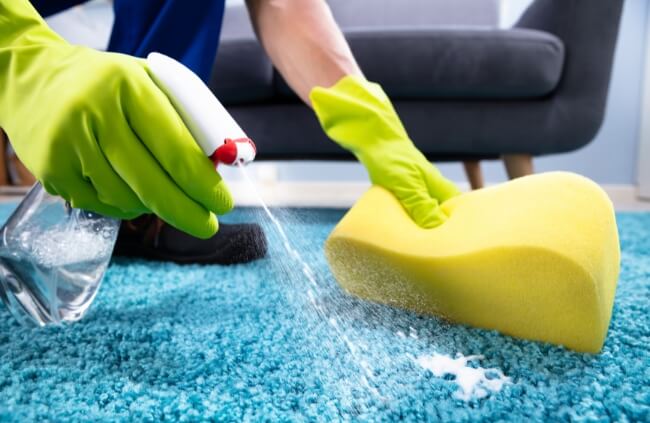
6. Rinse Your Rug
Rinse the soapy solution out of the rug using buckets of clean water or a garden hose set to a high-pressure setting. If applicable, rinse both sides if necessary.
Keep rinsing the rug until the runoff water is almost crystal clear – this will be a good indicator that the cleaning solution has been completely removed.
7. Remove any Excess Water
After rinsing your rug, you’ll want to remove as much excess water as possible so it can dry faster. The faster it dries the better! To achieve this, you can use a wet-dry vacuum cleaner if you have one or you can run a squeegee along the rug in the direction of the nap, which is the direction in which the fibres or pile lie.
Alternatively, hang your rug on a washing line to drip, rotating as needed until the excess moisture is gone.
8. Allow Your Rug to Dry
Lay your rug flat on the ground to allow the top to fully air dry, then flip it over to dry the bottom side. If you cleaned your rug indoors, fans can help speed things along. But for the best results, allow your rug to dry outside in the sun as UV rays are a natural disinfectant and deodoriser.
9. Finishing Off
Once your rug is completely dry, you can move it back to its original position indoors. During the cleaning, the threads and fibres will most likely become compacted, tangled, or squished – this is totally normal.
Revive the rug by brushing it with a soft-bristled brush or by running your vacuum over the dried rug. To finish off, you can spray a carpet or fabric refresher over your rug to help eliminate any trapped odours. Just make sure the refreshing spray is suitable for your rug material.
How to Clean a Rug: Frequently Asked Questions
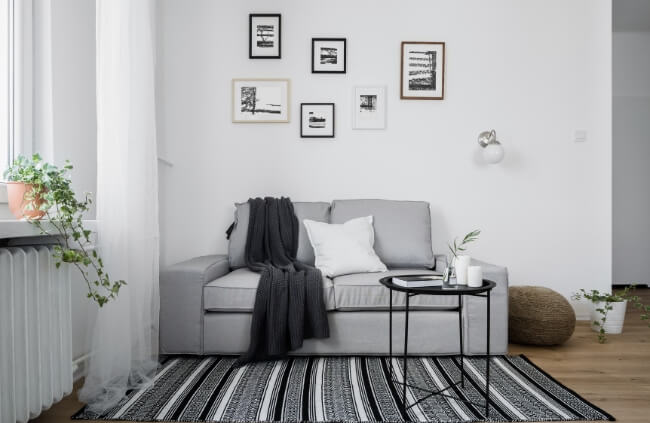
Does beating a rug with a broom work?
Yes! Beating rugs with a broom is surprisingly effective for removing dust and dry soils, which are usually most common on carpets and rugs. If you want to deep-clean your rug though, a broom unfortunately isn’t enough.
How often should I deep-clean area rugs?
Deep cleaning rugs is a great way to bring them back to life quickly! You don’t need to follow any specific schedule, simply clean your rugs when they are visibly dirty or have an odour.
How often should I vacuum my rugs?
This can vary depending on where the rug is situated and what materials it’s made from but on average, it is recommended to vacuum your rugs and carpets twice a week to keep them clean and looking fresh.
Is vinegar good for cleaning all rugs?
Unfortunately, vinegar is not suitable for cleaning every type of rug. Vinegar should only be used to treat smaller stains on synthetic fibre rugs.
Can I use baking soda to clean a rug?
Yes, baking soda is great for neutralising odours in rugs and can also be useful for removing stains as well. Sprinkle a few teaspoons of baking soda over your rug or problem areas then allow it to sit for about 15 minutes. Thereafter, vacuum as usual and then allow it to dry.
Call Myer Carpet Cleaning for Your Rug Maintenance Today!
At Myer Carpet Cleaning, we’ve set the benchmark for premium cleaning services across Australia!
With over 10 years of experience servicing homes and businesses in Melbourne, Sydney, Perth and Brisbane, we now offer a full suite of premium cleaning services for all your residential and commercial cleaning needs.
Our technicians are friendly, professional and reliable, and our products are 100% environmentally friendly and non-toxic. Book Myer Carpet Cleaning today or have a look at our service areas for more detailed information.
We look forward to taking care of your cleaning needs so you can take care of what really matters!
